Critical Analysis: Iron Supplementation During Pregnancy - SCBCH3001
VerifiedAdded on 2023/06/12
|7
|1682
|97
Essay
AI Summary
This essay examines the crucial role of iron during pregnancy, addressing the importance of iron for both the mother and fetus, potential risks associated with iron deficiency and supplementation, and alternative sources of iron. It highlights that iron is essential for hemoglobin production and placental development, while deficiencies can lead to anemia and adverse pregnancy outcomes. The essay discusses the benefits and drawbacks of iron supplements, emphasizing the need for appropriate dosages to avoid side effects. Alternatives to supplementation, such as Vitamin C-rich foods and natural remedies, are also explored. The author advocates for prescribed iron supplements for all pregnant women to ensure healthy iron levels, while also advising on balanced intake and alternative options. Desklib provides a platform for students to access similar past papers and solved assignments for their academic needs.
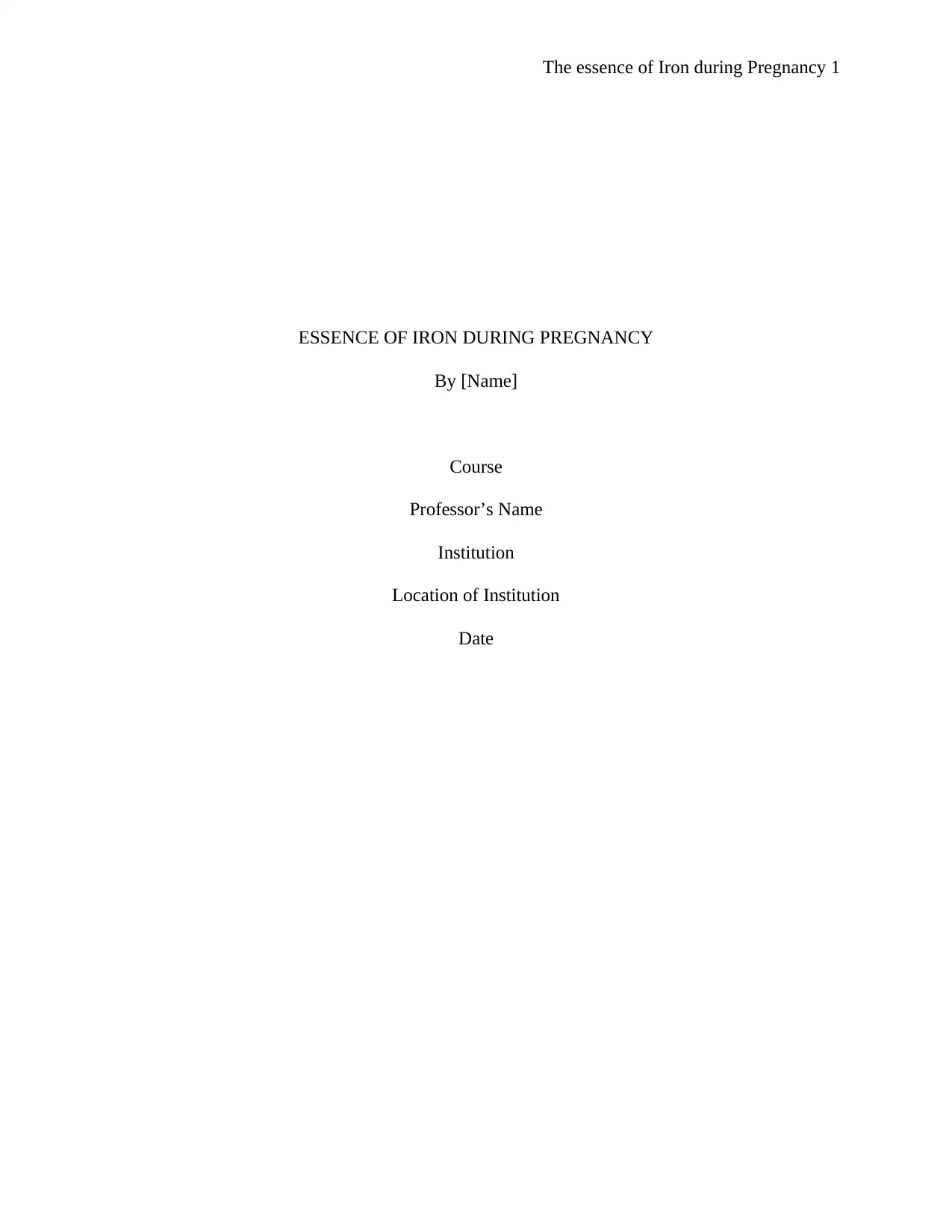
The essence of Iron during Pregnancy 1
ESSENCE OF IRON DURING PREGNANCY
By [Name]
Course
Professor’s Name
Institution
Location of Institution
Date
ESSENCE OF IRON DURING PREGNANCY
By [Name]
Course
Professor’s Name
Institution
Location of Institution
Date
Paraphrase This Document
Need a fresh take? Get an instant paraphrase of this document with our AI Paraphraser
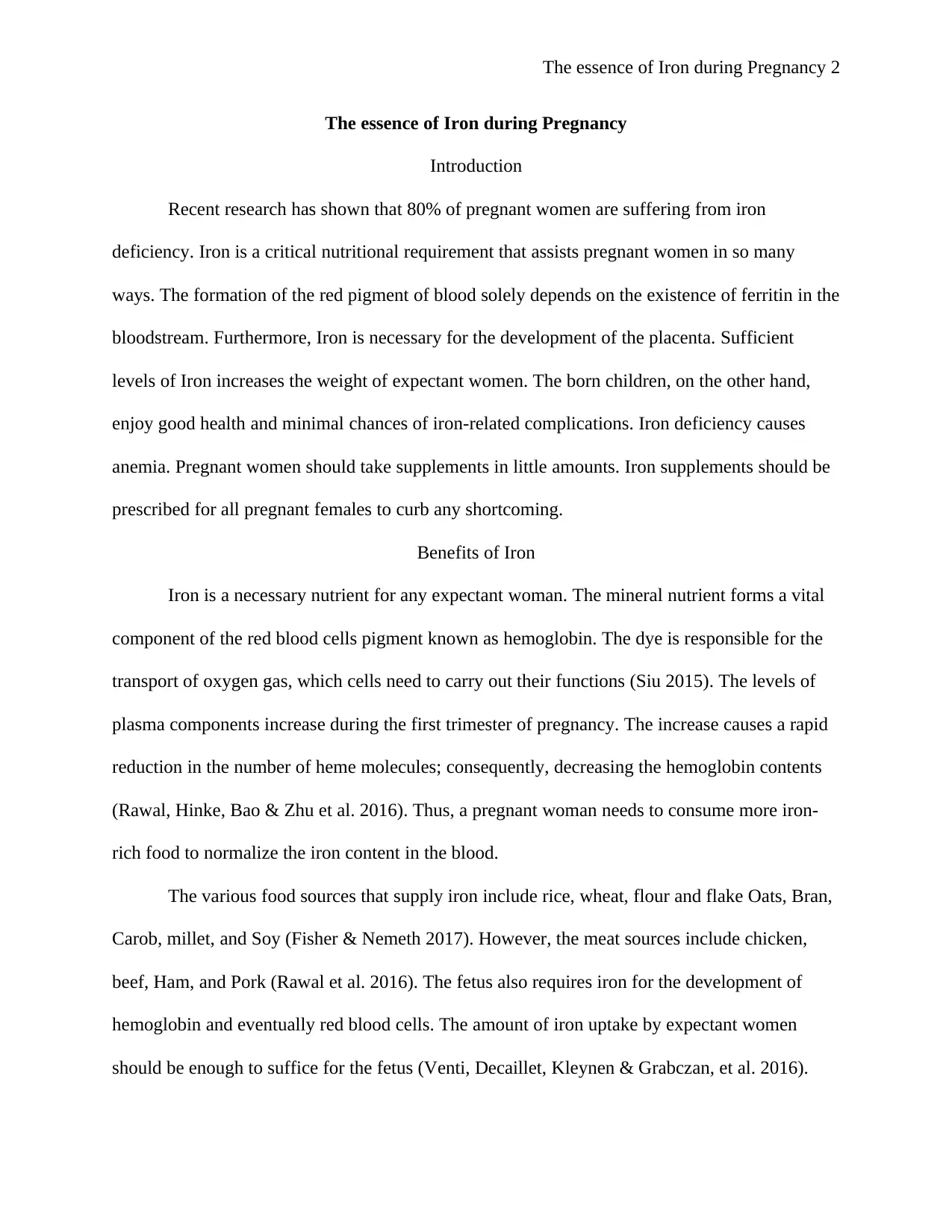
The essence of Iron during Pregnancy 2
The essence of Iron during Pregnancy
Introduction
Recent research has shown that 80% of pregnant women are suffering from iron
deficiency. Iron is a critical nutritional requirement that assists pregnant women in so many
ways. The formation of the red pigment of blood solely depends on the existence of ferritin in the
bloodstream. Furthermore, Iron is necessary for the development of the placenta. Sufficient
levels of Iron increases the weight of expectant women. The born children, on the other hand,
enjoy good health and minimal chances of iron-related complications. Iron deficiency causes
anemia. Pregnant women should take supplements in little amounts. Iron supplements should be
prescribed for all pregnant females to curb any shortcoming.
Benefits of Iron
Iron is a necessary nutrient for any expectant woman. The mineral nutrient forms a vital
component of the red blood cells pigment known as hemoglobin. The dye is responsible for the
transport of oxygen gas, which cells need to carry out their functions (Siu 2015). The levels of
plasma components increase during the first trimester of pregnancy. The increase causes a rapid
reduction in the number of heme molecules; consequently, decreasing the hemoglobin contents
(Rawal, Hinke, Bao & Zhu et al. 2016). Thus, a pregnant woman needs to consume more iron-
rich food to normalize the iron content in the blood.
The various food sources that supply iron include rice, wheat, flour and flake Oats, Bran,
Carob, millet, and Soy (Fisher & Nemeth 2017). However, the meat sources include chicken,
beef, Ham, and Pork (Rawal et al. 2016). The fetus also requires iron for the development of
hemoglobin and eventually red blood cells. The amount of iron uptake by expectant women
should be enough to suffice for the fetus (Venti, Decaillet, Kleynen & Grabczan, et al. 2016).
The essence of Iron during Pregnancy
Introduction
Recent research has shown that 80% of pregnant women are suffering from iron
deficiency. Iron is a critical nutritional requirement that assists pregnant women in so many
ways. The formation of the red pigment of blood solely depends on the existence of ferritin in the
bloodstream. Furthermore, Iron is necessary for the development of the placenta. Sufficient
levels of Iron increases the weight of expectant women. The born children, on the other hand,
enjoy good health and minimal chances of iron-related complications. Iron deficiency causes
anemia. Pregnant women should take supplements in little amounts. Iron supplements should be
prescribed for all pregnant females to curb any shortcoming.
Benefits of Iron
Iron is a necessary nutrient for any expectant woman. The mineral nutrient forms a vital
component of the red blood cells pigment known as hemoglobin. The dye is responsible for the
transport of oxygen gas, which cells need to carry out their functions (Siu 2015). The levels of
plasma components increase during the first trimester of pregnancy. The increase causes a rapid
reduction in the number of heme molecules; consequently, decreasing the hemoglobin contents
(Rawal, Hinke, Bao & Zhu et al. 2016). Thus, a pregnant woman needs to consume more iron-
rich food to normalize the iron content in the blood.
The various food sources that supply iron include rice, wheat, flour and flake Oats, Bran,
Carob, millet, and Soy (Fisher & Nemeth 2017). However, the meat sources include chicken,
beef, Ham, and Pork (Rawal et al. 2016). The fetus also requires iron for the development of
hemoglobin and eventually red blood cells. The amount of iron uptake by expectant women
should be enough to suffice for the fetus (Venti, Decaillet, Kleynen & Grabczan, et al. 2016).
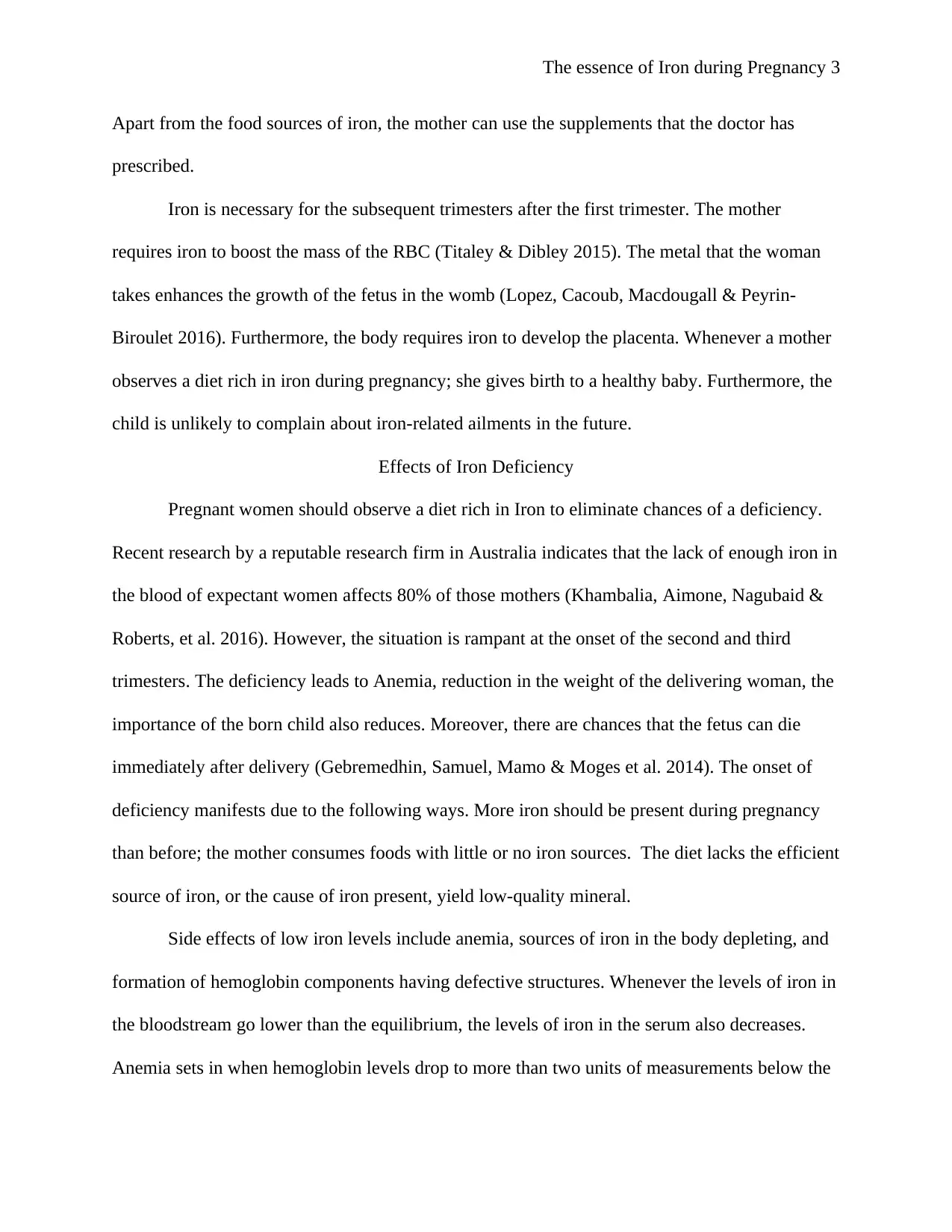
The essence of Iron during Pregnancy 3
Apart from the food sources of iron, the mother can use the supplements that the doctor has
prescribed.
Iron is necessary for the subsequent trimesters after the first trimester. The mother
requires iron to boost the mass of the RBC (Titaley & Dibley 2015). The metal that the woman
takes enhances the growth of the fetus in the womb (Lopez, Cacoub, Macdougall & Peyrin-
Biroulet 2016). Furthermore, the body requires iron to develop the placenta. Whenever a mother
observes a diet rich in iron during pregnancy; she gives birth to a healthy baby. Furthermore, the
child is unlikely to complain about iron-related ailments in the future.
Effects of Iron Deficiency
Pregnant women should observe a diet rich in Iron to eliminate chances of a deficiency.
Recent research by a reputable research firm in Australia indicates that the lack of enough iron in
the blood of expectant women affects 80% of those mothers (Khambalia, Aimone, Nagubaid &
Roberts, et al. 2016). However, the situation is rampant at the onset of the second and third
trimesters. The deficiency leads to Anemia, reduction in the weight of the delivering woman, the
importance of the born child also reduces. Moreover, there are chances that the fetus can die
immediately after delivery (Gebremedhin, Samuel, Mamo & Moges et al. 2014). The onset of
deficiency manifests due to the following ways. More iron should be present during pregnancy
than before; the mother consumes foods with little or no iron sources. The diet lacks the efficient
source of iron, or the cause of iron present, yield low-quality mineral.
Side effects of low iron levels include anemia, sources of iron in the body depleting, and
formation of hemoglobin components having defective structures. Whenever the levels of iron in
the bloodstream go lower than the equilibrium, the levels of iron in the serum also decreases.
Anemia sets in when hemoglobin levels drop to more than two units of measurements below the
Apart from the food sources of iron, the mother can use the supplements that the doctor has
prescribed.
Iron is necessary for the subsequent trimesters after the first trimester. The mother
requires iron to boost the mass of the RBC (Titaley & Dibley 2015). The metal that the woman
takes enhances the growth of the fetus in the womb (Lopez, Cacoub, Macdougall & Peyrin-
Biroulet 2016). Furthermore, the body requires iron to develop the placenta. Whenever a mother
observes a diet rich in iron during pregnancy; she gives birth to a healthy baby. Furthermore, the
child is unlikely to complain about iron-related ailments in the future.
Effects of Iron Deficiency
Pregnant women should observe a diet rich in Iron to eliminate chances of a deficiency.
Recent research by a reputable research firm in Australia indicates that the lack of enough iron in
the blood of expectant women affects 80% of those mothers (Khambalia, Aimone, Nagubaid &
Roberts, et al. 2016). However, the situation is rampant at the onset of the second and third
trimesters. The deficiency leads to Anemia, reduction in the weight of the delivering woman, the
importance of the born child also reduces. Moreover, there are chances that the fetus can die
immediately after delivery (Gebremedhin, Samuel, Mamo & Moges et al. 2014). The onset of
deficiency manifests due to the following ways. More iron should be present during pregnancy
than before; the mother consumes foods with little or no iron sources. The diet lacks the efficient
source of iron, or the cause of iron present, yield low-quality mineral.
Side effects of low iron levels include anemia, sources of iron in the body depleting, and
formation of hemoglobin components having defective structures. Whenever the levels of iron in
the bloodstream go lower than the equilibrium, the levels of iron in the serum also decreases.
Anemia sets in when hemoglobin levels drop to more than two units of measurements below the
⊘ This is a preview!⊘
Do you want full access?
Subscribe today to unlock all pages.

Trusted by 1+ million students worldwide
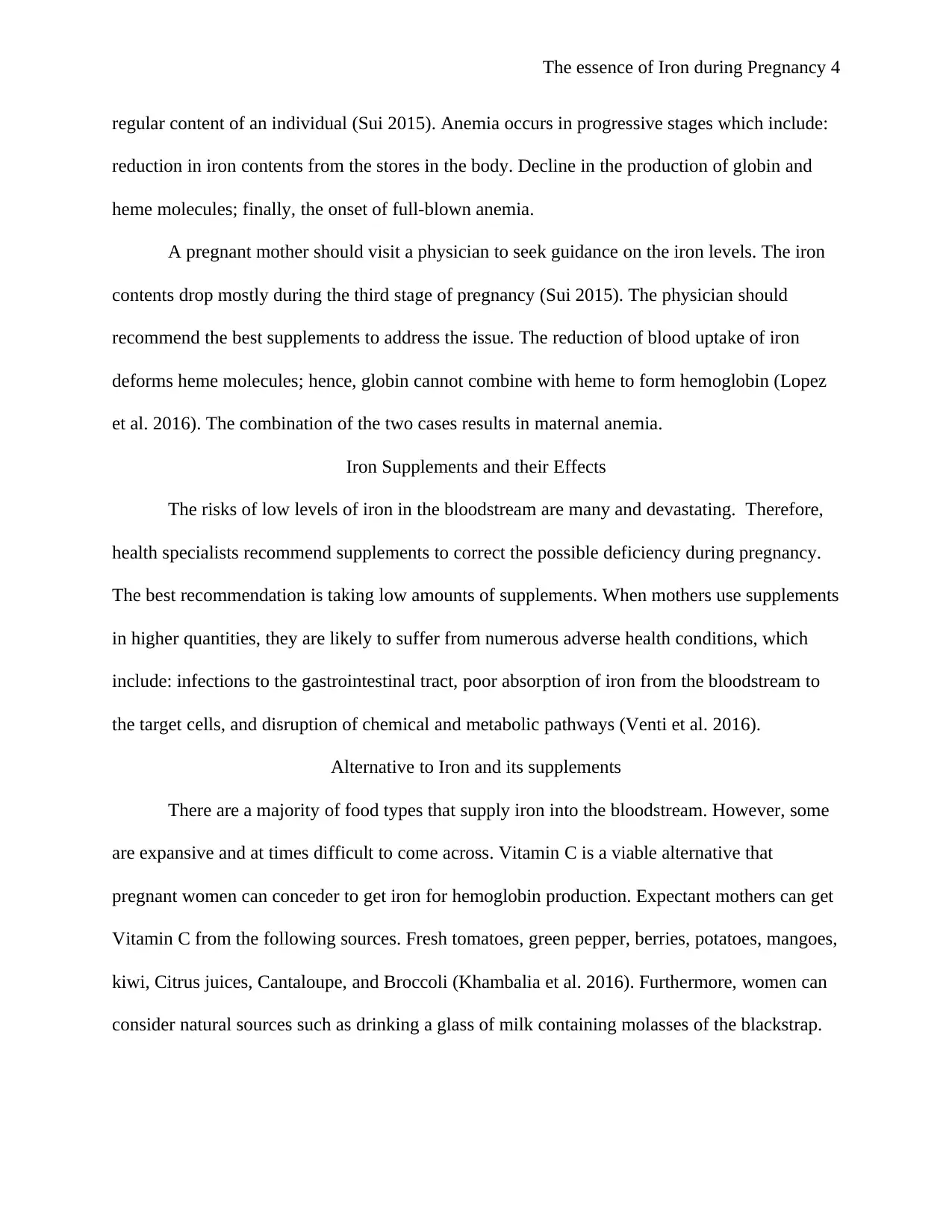
The essence of Iron during Pregnancy 4
regular content of an individual (Sui 2015). Anemia occurs in progressive stages which include:
reduction in iron contents from the stores in the body. Decline in the production of globin and
heme molecules; finally, the onset of full-blown anemia.
A pregnant mother should visit a physician to seek guidance on the iron levels. The iron
contents drop mostly during the third stage of pregnancy (Sui 2015). The physician should
recommend the best supplements to address the issue. The reduction of blood uptake of iron
deforms heme molecules; hence, globin cannot combine with heme to form hemoglobin (Lopez
et al. 2016). The combination of the two cases results in maternal anemia.
Iron Supplements and their Effects
The risks of low levels of iron in the bloodstream are many and devastating. Therefore,
health specialists recommend supplements to correct the possible deficiency during pregnancy.
The best recommendation is taking low amounts of supplements. When mothers use supplements
in higher quantities, they are likely to suffer from numerous adverse health conditions, which
include: infections to the gastrointestinal tract, poor absorption of iron from the bloodstream to
the target cells, and disruption of chemical and metabolic pathways (Venti et al. 2016).
Alternative to Iron and its supplements
There are a majority of food types that supply iron into the bloodstream. However, some
are expansive and at times difficult to come across. Vitamin C is a viable alternative that
pregnant women can conceder to get iron for hemoglobin production. Expectant mothers can get
Vitamin C from the following sources. Fresh tomatoes, green pepper, berries, potatoes, mangoes,
kiwi, Citrus juices, Cantaloupe, and Broccoli (Khambalia et al. 2016). Furthermore, women can
consider natural sources such as drinking a glass of milk containing molasses of the blackstrap.
regular content of an individual (Sui 2015). Anemia occurs in progressive stages which include:
reduction in iron contents from the stores in the body. Decline in the production of globin and
heme molecules; finally, the onset of full-blown anemia.
A pregnant mother should visit a physician to seek guidance on the iron levels. The iron
contents drop mostly during the third stage of pregnancy (Sui 2015). The physician should
recommend the best supplements to address the issue. The reduction of blood uptake of iron
deforms heme molecules; hence, globin cannot combine with heme to form hemoglobin (Lopez
et al. 2016). The combination of the two cases results in maternal anemia.
Iron Supplements and their Effects
The risks of low levels of iron in the bloodstream are many and devastating. Therefore,
health specialists recommend supplements to correct the possible deficiency during pregnancy.
The best recommendation is taking low amounts of supplements. When mothers use supplements
in higher quantities, they are likely to suffer from numerous adverse health conditions, which
include: infections to the gastrointestinal tract, poor absorption of iron from the bloodstream to
the target cells, and disruption of chemical and metabolic pathways (Venti et al. 2016).
Alternative to Iron and its supplements
There are a majority of food types that supply iron into the bloodstream. However, some
are expansive and at times difficult to come across. Vitamin C is a viable alternative that
pregnant women can conceder to get iron for hemoglobin production. Expectant mothers can get
Vitamin C from the following sources. Fresh tomatoes, green pepper, berries, potatoes, mangoes,
kiwi, Citrus juices, Cantaloupe, and Broccoli (Khambalia et al. 2016). Furthermore, women can
consider natural sources such as drinking a glass of milk containing molasses of the blackstrap.
Paraphrase This Document
Need a fresh take? Get an instant paraphrase of this document with our AI Paraphraser
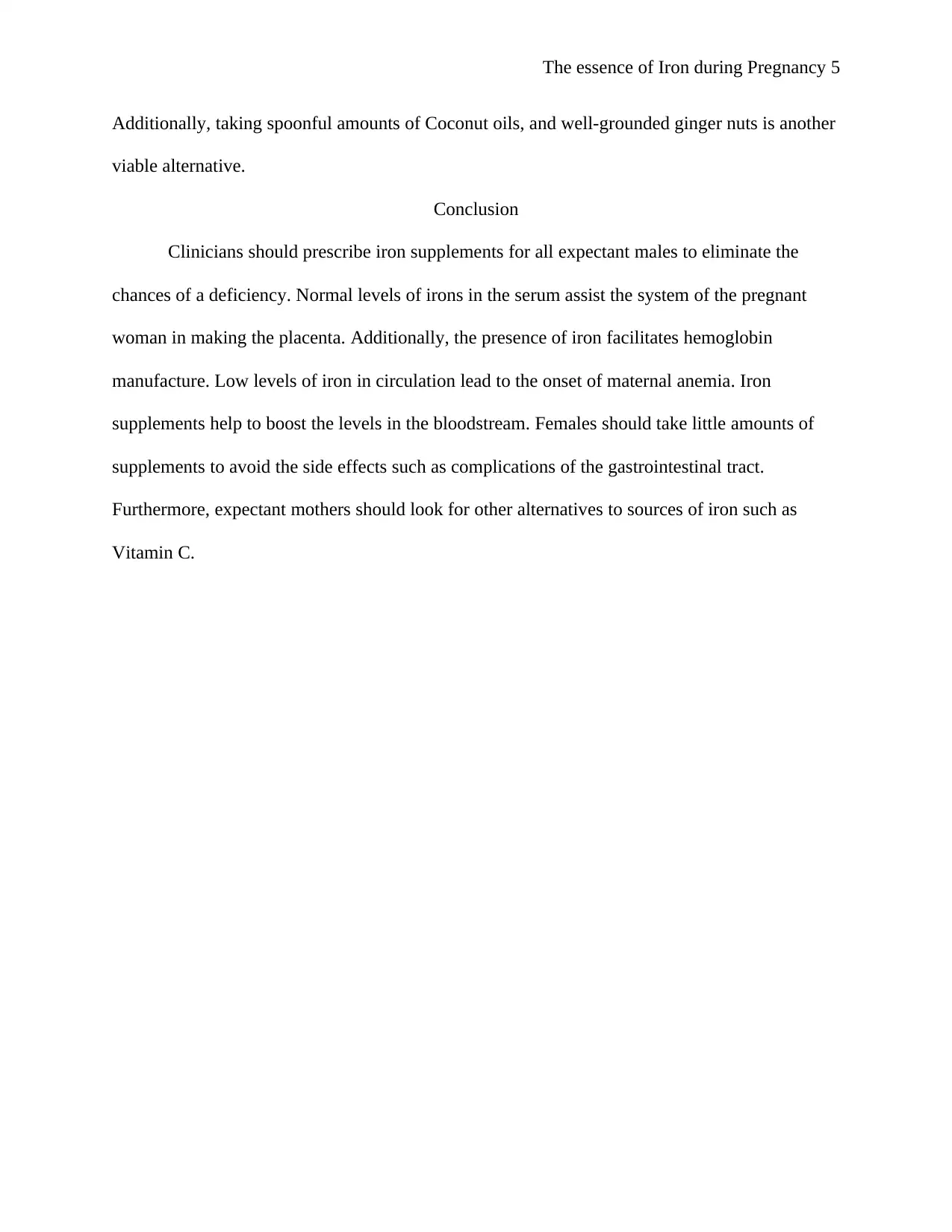
The essence of Iron during Pregnancy 5
Additionally, taking spoonful amounts of Coconut oils, and well-grounded ginger nuts is another
viable alternative.
Conclusion
Clinicians should prescribe iron supplements for all expectant males to eliminate the
chances of a deficiency. Normal levels of irons in the serum assist the system of the pregnant
woman in making the placenta. Additionally, the presence of iron facilitates hemoglobin
manufacture. Low levels of iron in circulation lead to the onset of maternal anemia. Iron
supplements help to boost the levels in the bloodstream. Females should take little amounts of
supplements to avoid the side effects such as complications of the gastrointestinal tract.
Furthermore, expectant mothers should look for other alternatives to sources of iron such as
Vitamin C.
Additionally, taking spoonful amounts of Coconut oils, and well-grounded ginger nuts is another
viable alternative.
Conclusion
Clinicians should prescribe iron supplements for all expectant males to eliminate the
chances of a deficiency. Normal levels of irons in the serum assist the system of the pregnant
woman in making the placenta. Additionally, the presence of iron facilitates hemoglobin
manufacture. Low levels of iron in circulation lead to the onset of maternal anemia. Iron
supplements help to boost the levels in the bloodstream. Females should take little amounts of
supplements to avoid the side effects such as complications of the gastrointestinal tract.
Furthermore, expectant mothers should look for other alternatives to sources of iron such as
Vitamin C.
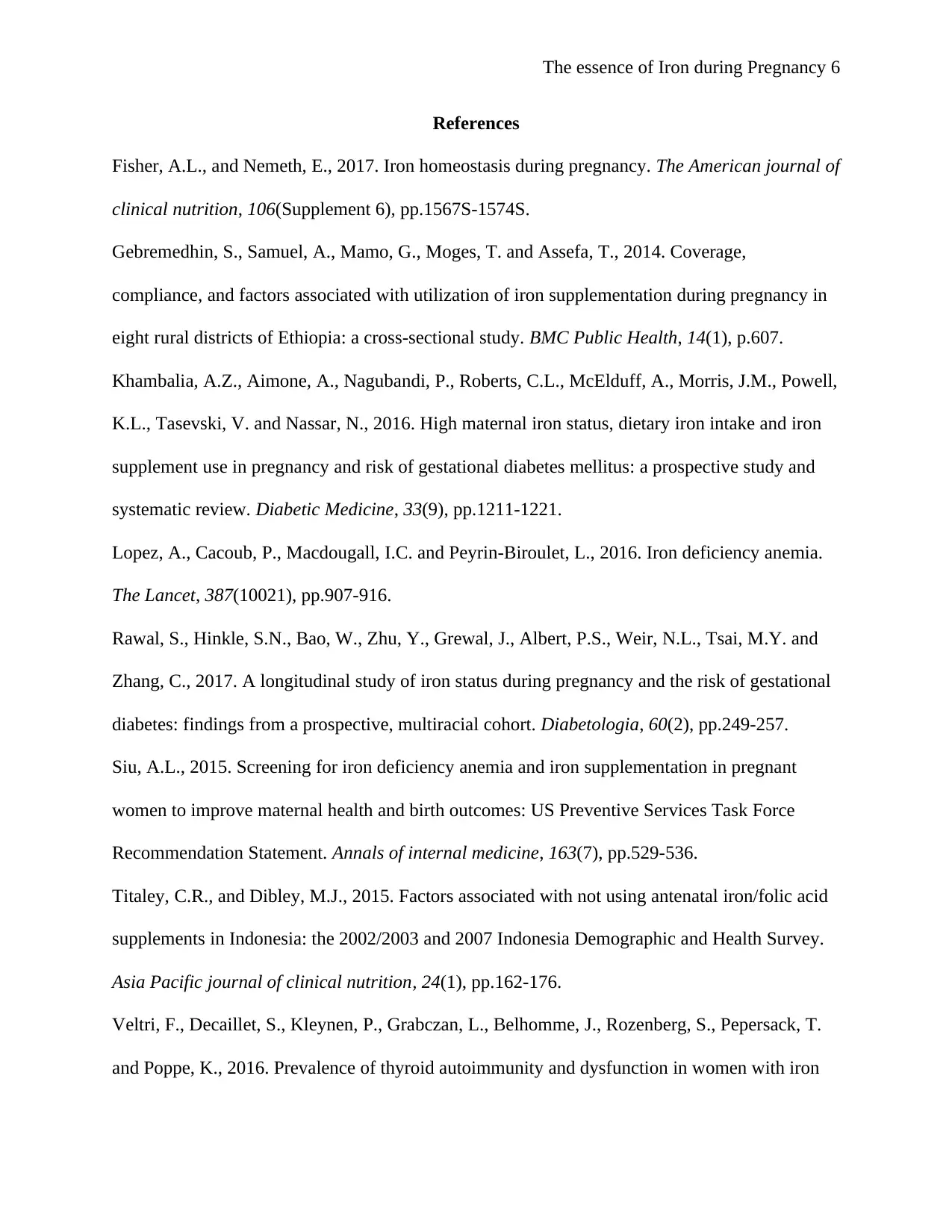
The essence of Iron during Pregnancy 6
References
Fisher, A.L., and Nemeth, E., 2017. Iron homeostasis during pregnancy. The American journal of
clinical nutrition, 106(Supplement 6), pp.1567S-1574S.
Gebremedhin, S., Samuel, A., Mamo, G., Moges, T. and Assefa, T., 2014. Coverage,
compliance, and factors associated with utilization of iron supplementation during pregnancy in
eight rural districts of Ethiopia: a cross-sectional study. BMC Public Health, 14(1), p.607.
Khambalia, A.Z., Aimone, A., Nagubandi, P., Roberts, C.L., McElduff, A., Morris, J.M., Powell,
K.L., Tasevski, V. and Nassar, N., 2016. High maternal iron status, dietary iron intake and iron
supplement use in pregnancy and risk of gestational diabetes mellitus: a prospective study and
systematic review. Diabetic Medicine, 33(9), pp.1211-1221.
Lopez, A., Cacoub, P., Macdougall, I.C. and Peyrin-Biroulet, L., 2016. Iron deficiency anemia.
The Lancet, 387(10021), pp.907-916.
Rawal, S., Hinkle, S.N., Bao, W., Zhu, Y., Grewal, J., Albert, P.S., Weir, N.L., Tsai, M.Y. and
Zhang, C., 2017. A longitudinal study of iron status during pregnancy and the risk of gestational
diabetes: findings from a prospective, multiracial cohort. Diabetologia, 60(2), pp.249-257.
Siu, A.L., 2015. Screening for iron deficiency anemia and iron supplementation in pregnant
women to improve maternal health and birth outcomes: US Preventive Services Task Force
Recommendation Statement. Annals of internal medicine, 163(7), pp.529-536.
Titaley, C.R., and Dibley, M.J., 2015. Factors associated with not using antenatal iron/folic acid
supplements in Indonesia: the 2002/2003 and 2007 Indonesia Demographic and Health Survey.
Asia Pacific journal of clinical nutrition, 24(1), pp.162-176.
Veltri, F., Decaillet, S., Kleynen, P., Grabczan, L., Belhomme, J., Rozenberg, S., Pepersack, T.
and Poppe, K., 2016. Prevalence of thyroid autoimmunity and dysfunction in women with iron
References
Fisher, A.L., and Nemeth, E., 2017. Iron homeostasis during pregnancy. The American journal of
clinical nutrition, 106(Supplement 6), pp.1567S-1574S.
Gebremedhin, S., Samuel, A., Mamo, G., Moges, T. and Assefa, T., 2014. Coverage,
compliance, and factors associated with utilization of iron supplementation during pregnancy in
eight rural districts of Ethiopia: a cross-sectional study. BMC Public Health, 14(1), p.607.
Khambalia, A.Z., Aimone, A., Nagubandi, P., Roberts, C.L., McElduff, A., Morris, J.M., Powell,
K.L., Tasevski, V. and Nassar, N., 2016. High maternal iron status, dietary iron intake and iron
supplement use in pregnancy and risk of gestational diabetes mellitus: a prospective study and
systematic review. Diabetic Medicine, 33(9), pp.1211-1221.
Lopez, A., Cacoub, P., Macdougall, I.C. and Peyrin-Biroulet, L., 2016. Iron deficiency anemia.
The Lancet, 387(10021), pp.907-916.
Rawal, S., Hinkle, S.N., Bao, W., Zhu, Y., Grewal, J., Albert, P.S., Weir, N.L., Tsai, M.Y. and
Zhang, C., 2017. A longitudinal study of iron status during pregnancy and the risk of gestational
diabetes: findings from a prospective, multiracial cohort. Diabetologia, 60(2), pp.249-257.
Siu, A.L., 2015. Screening for iron deficiency anemia and iron supplementation in pregnant
women to improve maternal health and birth outcomes: US Preventive Services Task Force
Recommendation Statement. Annals of internal medicine, 163(7), pp.529-536.
Titaley, C.R., and Dibley, M.J., 2015. Factors associated with not using antenatal iron/folic acid
supplements in Indonesia: the 2002/2003 and 2007 Indonesia Demographic and Health Survey.
Asia Pacific journal of clinical nutrition, 24(1), pp.162-176.
Veltri, F., Decaillet, S., Kleynen, P., Grabczan, L., Belhomme, J., Rozenberg, S., Pepersack, T.
and Poppe, K., 2016. Prevalence of thyroid autoimmunity and dysfunction in women with iron
⊘ This is a preview!⊘
Do you want full access?
Subscribe today to unlock all pages.

Trusted by 1+ million students worldwide
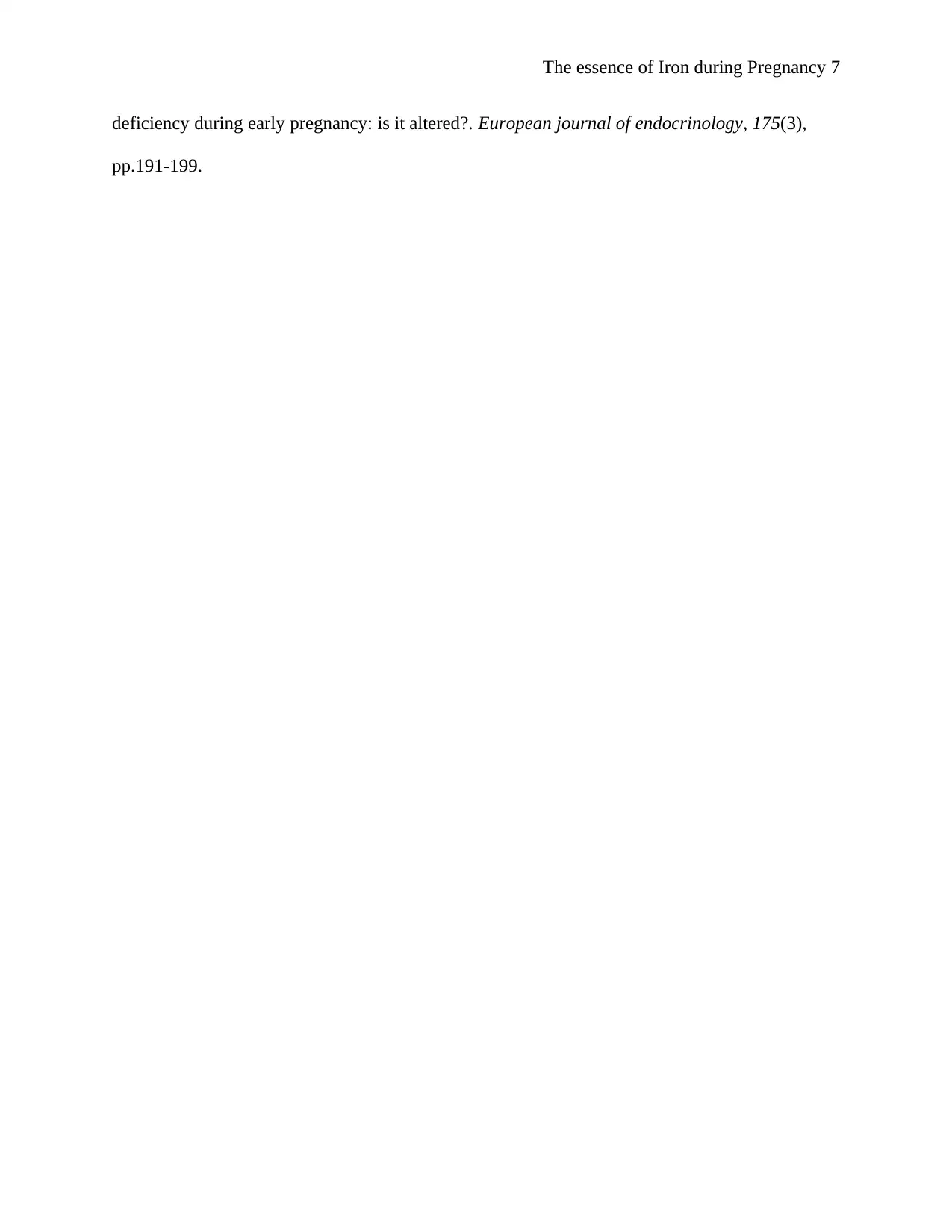
The essence of Iron during Pregnancy 7
deficiency during early pregnancy: is it altered?. European journal of endocrinology, 175(3),
pp.191-199.
deficiency during early pregnancy: is it altered?. European journal of endocrinology, 175(3),
pp.191-199.
1 out of 7
Related Documents
Your All-in-One AI-Powered Toolkit for Academic Success.
+13062052269
info@desklib.com
Available 24*7 on WhatsApp / Email
![[object Object]](/_next/static/media/star-bottom.7253800d.svg)
Unlock your academic potential
Copyright © 2020–2025 A2Z Services. All Rights Reserved. Developed and managed by ZUCOL.





